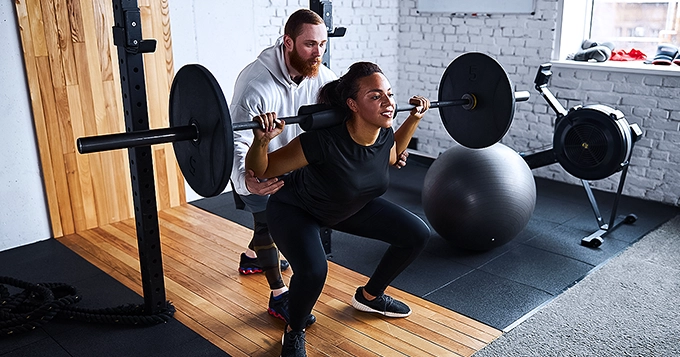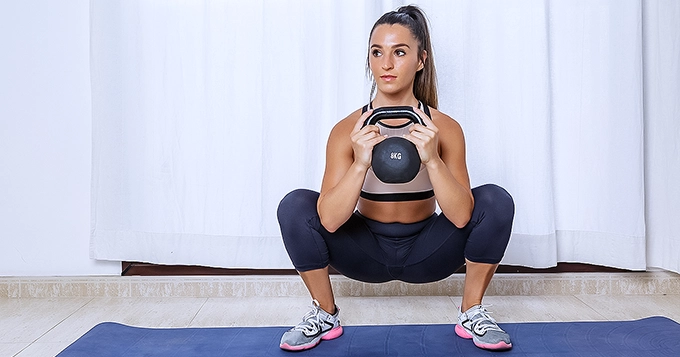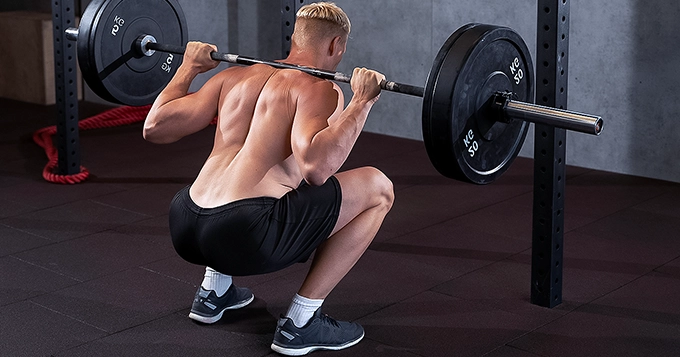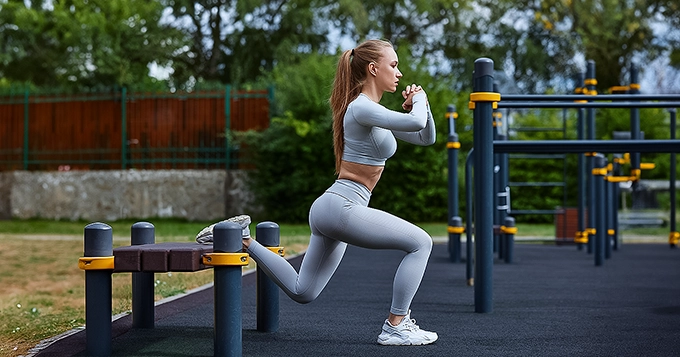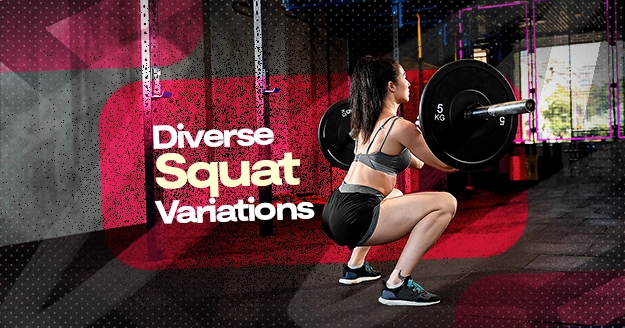Few exercises are as practical as squats when building strength, improving athletic performance, and sculpting your lower body. But did you know that sticking to just one type of squat can limit your potential gains?
What do squats work? Squats work the quads, glutes, hamstrings, and calves, among other lower body muscles. They also strengthen the core, which provides stability. Imagine discovering a wealth of squat variations, each providing distinct advantages and obstacles, turning your fitness regimen into a thrilling and dynamic adventure.
Basic Squat Variations
They build a solid foundation by perfecting the fundamentals before moving on to more complex and specialized squat variations. These fundamental squat variations are the foundation of your strength, technique, and preparedness for increasingly tricky exercises. They are accessible to beginners and compelling enough to be a staple in any seasoned athlete’s routine, providing a reassuring and confidence-boosting start to your fitness journey.
The Body Weight Squat
It is a foundational exercise that requires no equipment, making it perfect for beginners. To perform a bodyweight squat:
- Place your feet slightly outward while keeping your feet shoulder-width apart.
- Maintain an engaged core, shoulders back, and chest up.
- Lower your body as though you were lounging in a chair by bending your hips and knees. Prevent your feet from inwardly contracting by keeping your knees over them.
- As soon as your thighs are parallel to the floor or as low as your mobility permits, push through your heels to return to the beginning position.
This exercise helps beginners learn proper squat form, enhances lower body strength and endurance, and improves mobility and flexibility.
The Goblet Squat
The goblet squat is another excellent basic variation that adds a weight element for additional challenges.
- Maintain a shoulder-width distance between your feet while clutching a dumbbell or kettlebell near your chest. Keep your core firm throughout the workout.
- Lower yourself by keeping your torso erect, bending your hips and knees, and ensuring your elbows stay inside your knees the entire way down.
- As far as your mobility permits, descend till your thighs are parallel to the floor, keeping your weight close to your chest. Then, to return to your initial position, push through your heels.
Due to the weight’s counterbalance, the goblet squat improves squat depth and form. It stabilizes the core muscles and strengthens the quads, glutes, and hamstrings. It is accessible for beginners while still providing a challenge for more advanced lifters.
Intermediate Squat Variations
Once you have mastered the basics, incorporating intermediate squat variations can significantly elevate your workout routine by increasing the complexity and intensity of your exercises. These variations introduce additional weight and demand more precise technique, helping to build greater strength and muscle mass.
The Back Squat
The back squat is a traditional form of the intermediate squat that requires placing a barbell across your upper back.
How to execute a back squat:
- Position yourself so the barbell comfortably rests on your traps and your feet are shoulder-width apart.
- Keep your chest up and core engaged, and maintain a neutral spine.
- Bending your knees and hips will help you lower your body while maintaining a flat heel and knee alignment over your toes.
- As your thighs are parallel to the floor or as low as your mobility permits, push through your heels to return to the beginning position.
The back squat is highly effective for building strength in the quads, glutes, hamstrings, and lower back. Additionally, it strengthens the entire athletic performance by activating the core for stability. Good form is necessary to avoid frequent errors like allowing the knees to fold inward or curving the lower back.
The Front Squat
The front squat is another excellent intermediate variation that shifts the focus slightly compared to the back squat. In a front squat:
- Hold the barbell before your shoulders, elbows up, and upper arms parallel to the floor.
- Maintain a straight core and an erect chest while standing with your feet shoulder-width apart.
- Bending your knees and hips will help you lower your body while keeping your torso straight and your elbows raised.
- To return to the starting position, push through your heels once your thighs parallel the floor or as deep as your mobility permits.
The front squat emphasizes the quads and core due to the anterior load. It also improves posture and enhances upper body strength and flexibility. Proper form is crucial to prevent the barbell from rolling forward or causing strain on the wrists and shoulders.
Advanced Squat Variations
For those who have built a strong foundation with basic and intermediate squat variations, advanced squat variations offer new challenges that can take your strength, balance, and flexibility to the next level. These variations require a high level of technique, skill, and body control, making them ideal for experienced lifters looking to push their limits.
The Overhead Squat
The overhead squat is a demanding advanced variation requiring excellent mobility, balance, and strength. To do an overhead squat, begin by:
- With a broad grip and fully extended arms, hold a barbell overhead.
- Maintain a raised chest and a tight core while standing with your feet shoulder-width apart.
- While keeping the barbell overhead and ensuring your arms stay straight and your chest stays erect, lower your body by bending your knees and hips.
- Once you’ve descended, push through your heels to get back to the starting position, maintaining your thighs as deep as your mobility will allow or parallel to the floor.
The shoulders, upper back, core, quadriceps, and glutes are among the muscles worked during an overhead squat. Additionally, it improves body coordination, mobility, and stability in the shoulder. Considering its intricacy, following the proper form and development is imperative to minimize risks and optimize advantages.
The Bulgarian Split Squat
The Bulgarian split squat is another advanced variation emphasizing single-leg strength and stability.
- Stand a few feet before a bench or elevated surface to perform a Bulgarian split squat.
- Step backward and put one foot on the bench. Ensure your front foot is far enough forward so that your knee stays behind your toes when you land.
- Maintain an active core and a rising chest.
- As deep as your mobility permits, or until your front thigh is parallel to the ground, lower your body by bending your front knee and hip.
- To get back to where you were, push through your front heel.
The Bulgarian split squat targets the quads, glutes, and hamstrings while improving balance and stability. It also helps address muscle imbalances between legs and enhances single-leg performance, which is crucial for athletic activities.
Plyometric and Dynamic Squat Variations
Plyometric and dynamic squat variations significantly increase your explosive power, speed, and agility as an athlete or fitness enthusiast. These intense workouts test your muscles and cardiovascular system by requiring them to function harder and more effectively. They involve quick motions and hops.
The Jump Squat
The jump squat is a fundamental plyometric exercise that combines the strength-building benefits of a traditional squat with the explosive power of a jump. To perform a jump squat:
- Place your feet shoulder-width apart, then bend your knees and hips to bring your body down into a squat. Ensure your chest stays up and your core is engaged.
- From the squat position, jump as high as possible, extending your legs fully and reaching your arms overhead.
- Land softly into the squat position to absorb the impact, then immediately repeat the movement.
Jump squats are highly effective for developing lower body power, improving vertical jump height, and enhancing overall athletic performance. They also engage the core and cardiovascular system, making them a great addition to high-intensity interval training (HIIT) workouts.
The Pistol Squat
The pistol squat, sometimes called the single-leg squat, is a difficult dynamic squat variation requiring high flexibility, balance, and strength. To perform a pistol squat:
- Stand on one leg with the other extended straight in front of you. Keep your chest up, core engaged, and arms extended forward for balance.
- To lower your body, bend the knee and hip of your standing leg while keeping your chest straight and your extended leg off the ground.
- Step down until your standing thigh is parallel to the floor or as low as your range of motion allows, and then push through your heel to return to the starting position.
The pistol squat targets the quads, glutes, hamstrings, and core while enhancing single-leg strength and stability. It also helps correct muscle imbalances and improves overall coordination and flexibility. Due to its complexity, proper progression and form are crucial to prevent injury.
Each types of squats targets different muscle groups and offers unique benefits, ensuring a well-rounded lower-body workout. Incorporating a variety of squats keeps your routine engaging and dynamic, preventing boredom and encouraging consistent progress.
Remember that the best way to reap the benefits of these exercises while minimizing the risk of injury is to practice excellent technique and progress gradually. Embrace squats’ versatility, and you’ll discover a powerful tool for achieving a stronger, more resilient, and well-balanced body.
